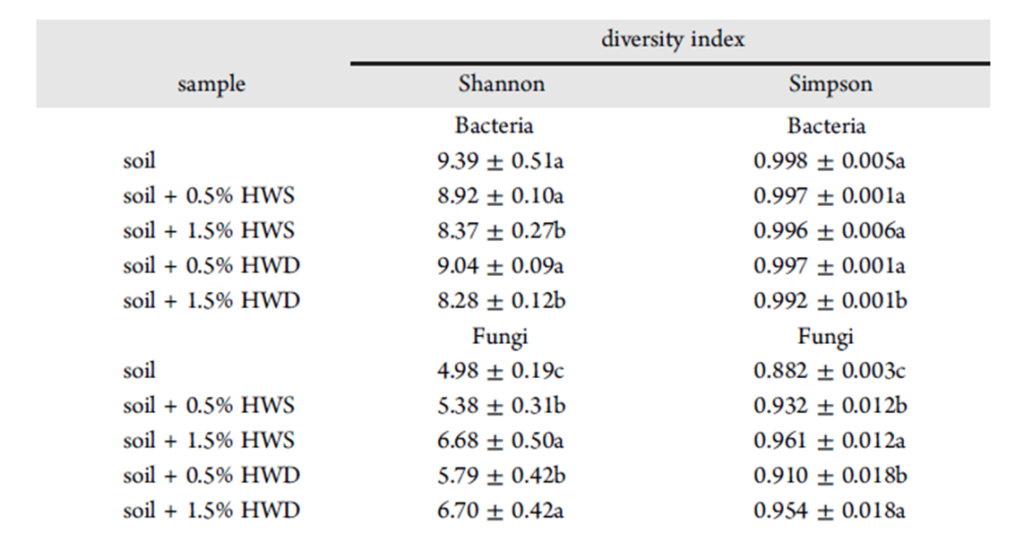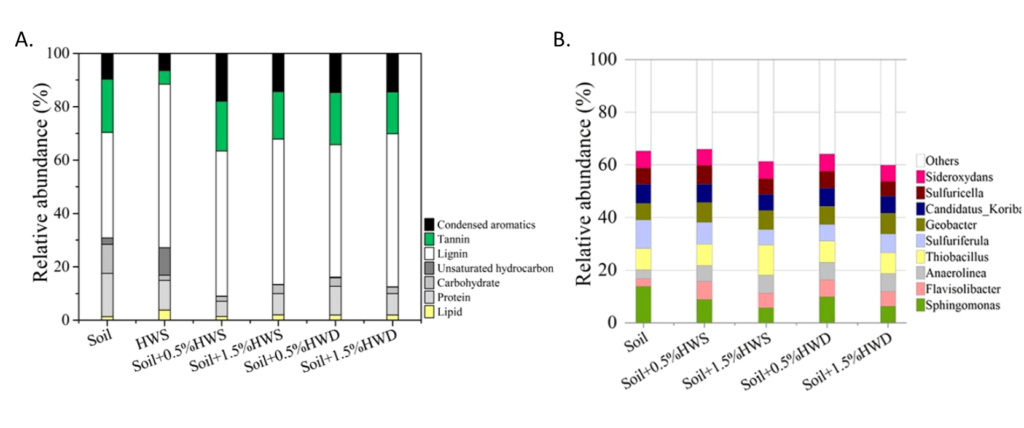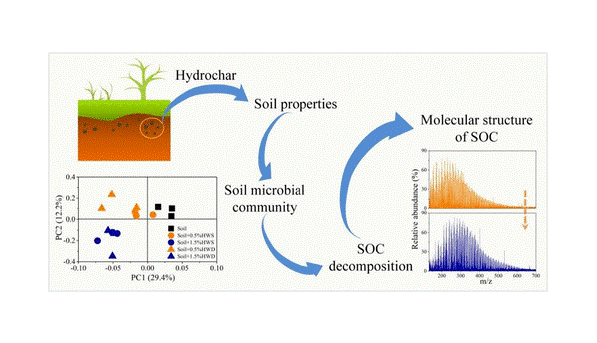Title: Application of Hydrochar Altered Soil Microbial Community Composition and the Molecular Structure of Native Soil Organic Carbon in a Paddy Soil
Authors: Ke Sun, Lanfang Han, Yan Yang, Xinghui Xia, Zhifeng Yang, Fengchang Wu, Fangbai Li, Yanfang Feng, Baoshan Xing
Journal: ACS Environmental Science and Technology
Year: 2020
https://pubs.acs.org/doi/10.1021/acs.est.9b05864
Figures reprinted with permission from Ke Sun, Lanfang Han, Yan Yang, et al., Application of Hydrochar Altered Soil Microbial Community Composition and the Molecular Structure of Native Soil Organic Carbon in a Paddy Soil. Environ. Sci. Technol. 2020. Copyright 2020 American Chemical Society.
With increases in deforestation and pollution over the past few centuries due to human activity, it has become more important than ever to maintain the health and vitality of the remaining forested areas on our planet. One popular method to keep forests healthy is to implement controlled burns where qualified experts set fire to a predetermined area of land (broadcast burning) or piles of human-collected debris (pile burning) at a time when environmental and weather conditions make it unlikely that the fire will spread [1]. There are many benefits to controlled burns, such as removing dead leaves and brush that could cause an out-of-control wildfire or destroying invasive plants [1]. In addition, controlled burns also return nutrients to the soil quickly by breaking dead plant matter down into its nutrient building blocks via fire instead of the natural decomposition process which can take years [1]. The nutrients in burned plant matter, also called ash [1], can greatly increase the health of growing plants in the area. Because of this, engineers have developed other thermochemical processes to break down vegetation into soil nutrient supplements (similar to ash and termed biochars and hydrochars) without the need for individual controlled burns as a source of nutrients.
Making biochars is similar to simply burning vegetation in that it requires dry starting material and very high temperatures (300-1200°C), but differs in that it requires low-oxygen conditions instead of the high oxygen required by a fire. Hydrochars, however, are more energy-efficient to make because they don’t require dry material or such high temperatures (only 180-375°C). This is due to the process of hydrothermal carbonization (HTC) where biomass and water in a closed container are heated past the boiling point of water, and the high temperature and pressure yields both a coal-like hydrochar as well as water-soluble byproducts which can be removed [2]. This hydrochar can contain nutrients such as nitrogen, phosphorous, and organic carbon (OC) that can help plants thrive, as in a previous study by Baronti and colleagues where addition of hydrochar made plants grow 20% taller [3]. OC in particular can both increase soil fertility and bind to pollutants in the soil to prevent them from flowing into groundwater.
Soil OC (SOC) is normally regulated by the natural decomposing machines in soil: fungi and bacteria. While previous reports (especially by Hu and colleagues [3]) have studied the effect of biochar addition on SOC composition as well as bacterial and fungal genus diversity, a recent study by Sun and colleagues is the first to examine the effect of the more energy-efficient hydrochar on these parameters. Changing the microorganism diversity and SOC composition through hydrochar application is not necessarily a bad thing; for example, the hydrochar might suppress the growth of bacterial strains that degrade pollutant-binding SOCs, causing pollutants to stay in the soil instead of contaminating precious groundwater. However, the opposite could be true, or the hydrochar could have no effect, but experiments are needed to determine the truth.
For this reason, Sun and colleagues created hydrochars from wood dust (HWD) and wheat straw (HWS) to represent the most types of biomass used to make hydrochars: wood and grass. They combined either 0.5% or 1.5% of each type to paddy soil collected in Yixing, Jiangsu Province, China. The soil-hydrochar mixtures were watered for 135 days to allow the microorganisms and SOC composition to change over time.
They found that the diversity of bacterial genera decreased in the presence of 0.5% HWD and 0.5% HWS (Table 1), but this difference was not statistically significant. 1.5% hydrochar however did show a significant decrease in bacterial diversity. In contrast, fungal genera diversity increased in the presence of all hydrochar conditions, particularly with 1.5% hydrochar addition. The scientists believed that this difference was mostly due to differences in pH between the plain soil (pH 6.91), soil + HWD (pH 6.13-6.75) and soil + HWS (pH 6.07-6.80) caused by the relatively acidic hydrochars (HWD at pH 3.74, HWS at pH 4.64). This is because fungi generally prefer acidic soil whereas bacteria prefer neutral soil. These results agree with the previous results of Hu and colleagues where biochar with a basic pH was added to relatively acidic soil, and this increased the bacterial diversity and decreased the fungal diversity [4].
Table 1. The Shannon and Simpson indices are two ways to measure the diversity of bacteria and fungi under different soil conditions. For each method, a higher index represents more diversity.

When investigating the organic carbon in their samples, the researchers found that soil with hydrochar added contained more aromatic SOCs and fewer carbohydrates and proteins than plain soil (Fig. 1A). Unlike the change in pH, the differences in SOC profiles with and without hydrochars could not simply be attributed to an addition of the soil profile and hydrochar profiles alone. Because SOC composition is generally controlled by microorganisms, the scientists looked back at their data for the bacteria present in each sample to find an explanation. Indeed, they saw that soil + hydrochar, especially 1.5%, had a lower level of Sphingomonas bacteria than soil alone (Fig. 1B), and these bacteria are known to decompose aromatic compounds. Similarly, addition of hydrochar increased the abundance of both Anaerolinea and Flabisolibacter bacteria which are known to decompose carbohydrates and proteins. Thus, the scientists concluded that SOC composition can be altered by hydrochars by changing soil conditions to favor or disfavor bacteria that preferably decompose some SOCs over others.

Because of the well-studied benefits of using the energy-efficient hydrochars to increase plant growth and prevent soil pollutants from entering ground water, hydrochar use is likely to continue to be popular in future years. Thus it is important to understand the impact of hydrochars on the microorganisms that live in the soil and control its composition. This study by Sun et al. provides important evidence that hydrochar addition can have downstream effects over time on both the living and non-living components of the soil, and this knowledge can lead to more informed decisions about hydrochar use in the future.
[1] https://www.nationalgeographic.org/encyclopedia/controlled-burning/
[2] https://htcycle.ag/en/process_40
[3] Baronti, S.; Alberti, G.; Camin, F.; Criscuoli, I.; Genesio, L.; Mass, R.; Vaccari, F. P.; Ziller, L.; Miglietta, F. Hydrochar enhances growth of poplar for bioenergy while marginally contributing to direct soil carbon sequestration. GCB Bioenergy 2017, 9, 1618−1626.
[4] Hu, L.; Cao, L.; Zhang, R. Bacterial and fungal taxon changes in soil microbial community composition induced by short-term biochar amendment in red oxidized loam soil. World J. Microbiol. Biotechnol. 2014, 30, 1085−1092.

